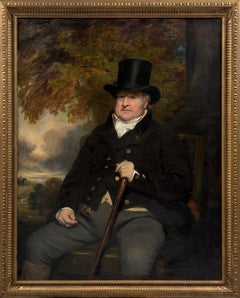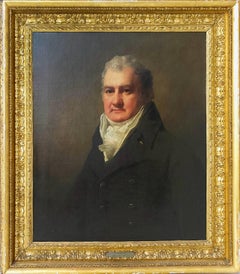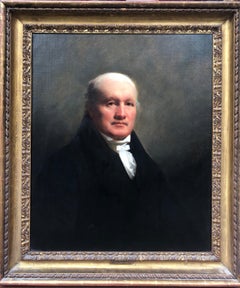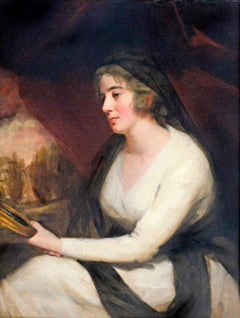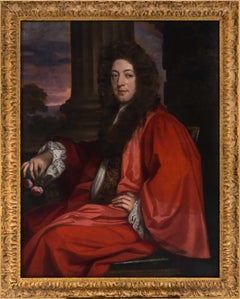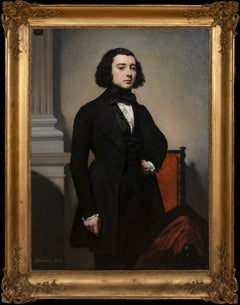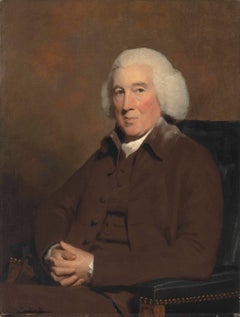Sir Henry Raeburn Art
British, 1756-1823
Sir Henry Raeburn, FRSE, RA, RSA (1756–1823) was a prominent Scottish portrait painter who is now largely credited for the revival of Scottish art in the early 19th century. Born in Stockbridge, Edinburgh, he was orphaned at a young age and subsequently educated at Heriot’s Hospital. He began his career as a goldsmith's apprentice, creating portrait miniatures before transitioning to oil painting, largely self-taught. Raeburn married the wealthy Ann Edgar, which enabled him to study art in Italy, where he was advised by Sir Joshua Reynolds and others. Upon returning to Edinburgh in 1787, Raeburn quickly gained success, painting notable figures like Sir Walter Scott and Dugald Stewart. He became known for his vigorous brushwork, strong characterizations, and dramatic lighting. His direct painting style and refusal to make preparatory sketches set him apart from contemporaries, incorporating elements of Romanticism. He was knighted by King George IV in 1822 and appointed the King’s limner for Scotland. He died in 1823 at his home in Stockbridge, Edinburgh.
This distinguished three-quarter length portrait depicts Elizabeth Clough (b. circa 1970-1770s), matriarch of the Clough family of Keighley, West Yorkshire. The piece was commissioned by her son, John Clough (1799–1863), a prominent engineer and industrialist in Keighley. Clough owned and operated Grove Mills, a major worsted spinning and manufacturing facility which employed a significant portion of the local workforce.
Elizabeth Clough is portrayed seated in an upholstered armchair, dressed in sober but elegant attire—a dark shawl and a crisp white cap tied beneath her chin. Her direct, steady gaze and flushed cheeks convey quiet strength and maternal dignity. The subdued, neutral background serves to emphasize the face and upper body, while still maintaining an airy and light feel. The face is rendered with sensitive modeling and naturalistic lighting, while the fabric of her garments contain blockier brushstrokes yet do not lose their sensitivity. These characteristics, combined with the information gleaned from the label, place this piece in the tradition of early 19th century Scottish portraiture.to
2
1
2
1
Overall Width
to
Overall Height
to
2
2
2
1
4
4
3
3
3
1
1
1
1
4
4
1
1
4
7,789
5,126
2,504
1,502
2
2
2
Artist: Sir Henry Raeburn
19th Century by Sir Henry Raeburn Portrait of a landowner Oil on canvas
By Sir Henry Raeburn
Located in Milano, Lombardia
Sir Henry Raeburn (Stockbridge, Edinburgh, UK, 1756 - Edinburgh, UK, 1823)
Title: Portrait of a landowner
Year: Early 19th century, 1803
Medium: Oil on canvas
Dimensions: Without fra...
Category
Early 19th Century Old Masters Sir Henry Raeburn Art
Materials
Canvas, Oil
Half Length Portrait of Mr. Robertson of Edinburgh
By Sir Henry Raeburn
Located in Miami, FL
Half Length Portrait of Mr. Robertson
Sir. Henry Raeburn ( Scottish 1756 - 1823 )
Half Length Portrait of Mr. Robertson
29x 24
Purchased, J Leger & Son,...
Category
18th Century Realist Sir Henry Raeburn Art
Materials
Oil
Striking 18th Century Portrait of the 12th Earl of Caithness
By Sir Henry Raeburn
Located in London, GB
Sir Henry Raeburn (1756-1823)
James Sinclair, 12th Earl of Caithness (1766-1823)
Oil on Canvas
30 X 25 inches Unframed
37 X 32 inches framed
Sir Henry Raeburn FRSE RA RSA (4 March 1756 – 8 July 1823) was a Scottish portrait painter and Scotland's first significant portrait painter since the Union to remain based in Scotland. He served as Portrait Painter to King George IV in Scotland.
Raeburn was born the son of a manufacturer in Stockbridge, on the Water of Leith: a former village now within the city of Edinburgh. He had an older brother, born in 1744, called William Raeburn. His ancestors were believed to have been soldiers, and may have taken the name "Raeburn" from a hill farm in Annandale, held by Sir Walter Scott's family. Orphaned, he was supported by William and placed in Heriot's Hospital, where he received an education. At the age of fifteen he was apprenticed to the goldsmith James Gilliland of Edinburgh, and various pieces of jewellery, mourning rings and the like, adorned with minute drawings on ivory by his hand, still exist. Soon he took to the production of carefully finished portrait miniatures; meeting with success and patronage, he extended his practice to oil painting, at which he was self-taught. Gilliland watched the progress of his pupil with interest, and introduced him to David Martin, who had been the favourite assistant of Allan Ramsay the Latter, and was now the leading portrait painter in Edinburgh. Raeburn was especially aided by the loan of portraits to copy. Soon he had gained sufficient skill to make him decide to devote himself exclusively to painting. George Chalmers (1776; Dunfermline Town Hall) is his earliest known portrait.
In his early twenties, Raeburn was asked to paint the portrait of a young lady he had noticed when he was sketching from nature in the fields. Ann was the daughter of Peter Edgar of Bridgelands, and widow of Count James Leslie of Deanhaugh. Fascinated by the handsome and intellectual young artist, she became his wife within a month, bringing him an ample fortune. The acquisition of wealth did not affect his enthusiasm or his industry, but spurred him on to acquire a thorough knowledge of his craft. It was usual for artists to visit Italy, and Raeburn set off with his wife. In London he was kindly received by Sir Joshua Reynolds, the president of the Royal Academy, who advised him on what to study in Rome, especially recommending the works of Michelangelo, and gave Raeburn letters of introduction for Italy. In Rome he met his fellow Scot Gavin Hamilton, Pompeo Girolamo Batoni and Byers, an antique dealer whose advice proved particularly useful, especially the recommendation that "he should never copy an object from memory, but, from the principal figure to the minutest accessory, have it placed before him." After two years of study in Italy he returned to Edinburgh in 1787, and began a successful career as a portrait painter. In that year he executed a seated portrait of the second Lord President Dundas.
Examples of his earlier portraiture include a bust of Mrs Johnstone of Baldovie and a three-quarter-length of Dr James Hutton: works which, if somewhat timid and tentative in handling and not as confident as his later work, nevertheless have delicacy and character. The portraits of John Clerk, Lord Eldin, and of Principal Hill of St Andrews belong to a later period. Raeburn was fortunate in the time in which he practised portraiture. Sir Walter Scott, Hugh Blair, Henry Mackenzie, Lord Woodhouselee, William Robertson, John Home, Robert Fergusson, and Dugald Stewart were resident in Edinburgh, and were all painted by Raeburn. Mature works include his own portrait and that of the Rev. Sir Henry Moncrieff Wellwood, a bust of Dr Wardrop of Torbane Hill, two full-lengths of Adam Rolland of Gask, the remarkable paintings of Lord Newton and Dr Alexander Adam in the National Gallery of Scotland, and that of William Macdonald of St Martin's. Apart from himself, Raeburn painted only two artists, one of whom was Sir Francis Leggatt Chantrey, the most important and famous British sculptor of the first half of the 19th century. It has recently been revealed that Raeburn and Chantrey were close friends and that Raeburn took exceptional care over the execution of his portrait of the sculptor, one of the painter's mature bust-length masterpieces.
It was commonly believed that Raeburn was less successful in painting female portraits, but the exquisite full-length of his wife, the smaller likeness of Mrs R. Scott Moncrieff in the National Gallery of Scotland, and that of Mrs Robert Bell, and others, argue against this. Raeburn spent his life in Edinburgh, rarely visiting London, and then only for brief periods, thus preserving his individuality. Although he, personally, may have lost advantages resulting from closer association with the leaders of English art, and from contact with a wider public, Scottish art gained much from his disinclination to leave his native land. He became the acknowledged chief of the school which was growing up in Scotland during the early 19th century, and his example and influence at a critical period were of major importance. So varied were his other interests that sitters used to say of him, "You would never take him for a painter till he seizes the brush and palette."
In 1812 he was elected president of the Society of Artists in Edinburgh; and in 1814 associate, and in the following year full member, of the Royal Scottish Academy. On 29 August 1822 he was knighted by George IV and appointed His Majesty's limner for Scotland at the Earl of Hopetoun house. He died in Edinburgh.
Raeburn had all the essential qualities of a popular and successful portrait painter. He was able to produce a telling and forcible likeness; his work is distinguished by powerful characterisation, stark realism, dramatic and unusual lighting effects, and swift and broad handling of the most resolute sort. David Wilkie recorded that, while travelling in Spain and studying the works of Diego Velázquez, the brushwork reminded him constantly of the "square touch" of Raeburn. Scottish physician and writer John Brown wrote that Raeburn "never fails in giving a likeness at once vivid, unmistakable and pleasing. He paints the truth, and he paints it with love".
Raeburn has been described as a "famously intuitive"portrait painter. He was unusual amongst many of his contemporaries, such as Reynolds, in the extent of his philosophy of painting directly from life; he made no preliminary sketches. This attitude partly explains the often coarse modelling and clashing colour combinations he employed, in contrast to the more refined style of Thomas Gainsborough and Reynolds. However these qualities and those mentioned above anticipate many of the later developments in painting of the 19th century from romanticism to Impressionism.
Sir Henry Raeburn died in St Bernard's House (17 St Bernards Crescent), Stockbridge, Edinburgh. He is buried in St. Cuthbert's churchyard against the east wall (the monument erected by Raeburn in advance) but also has a secondary memorial in the Church of St John the Evangelist, Edinburgh.
James Sinclair, 12th Earl of Caithness was born at Barrogill Castle (Castle of Mey) on 31 May 1766. He was the son of Sir John Sinclair of Mey, Baronet who he succeeded in the baronetcy in 1774. He succeeded as 12th earl of Caithness in 1789.
He was lord-lieutenant of the county of Caithness and lieutenant-colonel of the Ross-shire militia.
He married at Thurso Castle on 2 January 1784 Jane, second daughter of Alexander Campbell...
Category
18th Century Sir Henry Raeburn Art
Materials
Oil
Portrait of Mrs. Johnstone
By Sir Henry Raeburn
Located in Miami, FL
This is one of Raeburns best works from his best period that is not in a museum or private collection.
Three-quarter length portrait, seated in a white dress with a black scarf over...
Category
Early 1800s Realist Sir Henry Raeburn Art
Materials
Oil
Related Items
Portrait of a Gentleman in Scarlet Robe Holding Flowers c.1675, Oil on canvas
Located in London, GB
Titan Fine Art present this striking portrait, which was painted by one of the most talented artists working in England during the last half of the 17th century, John Greenhill. Gre...
Category
17th Century Old Masters Sir Henry Raeburn Art
Materials
Canvas, Oil
H 55.12 in W 44.1 in D 2.37 in
Portrait Of A Young Gentleman, circa 1810 by Louis DEVEDEUX (1820-1874)
Located in Blackwater, GB
Portrait Of A Young Gentleman, 19th Century
by Louis DEVEDEUX (1820-1874) sales to $40,000
Huge circa 1850 French portrait of a young gentleman, oil on canvas. Excellent quality an...
Category
19th Century Sir Henry Raeburn Art
Materials
Canvas, Oil
Portrait of Catherine Murray, Countess of Dysart, Roses, Gilded Frame, Van Dyke
By Anthony van Dyck
Located in London, GB
This exquisite Grand Manner work, presented by Titan Fine Art, is an evocative example of the type of portrait in vogue during the seventeenth and eighteenth centuries. Beautifully ...
Category
17th Century Old Masters Sir Henry Raeburn Art
Materials
Canvas, Oil
H 59.45 in W 51.19 in D 3.94 in
18th century Dutch portrait of a family group in an interior
Located in Bath, Somerset
An 18th century painting of a family group (otherwise known as a ‘conversation piece’) gathered around a table, an open door to the garden beyond. The father seated, with his son standing by his side, the mother seated, playing with a child on her lap, with another lady, possibly a maid standing behind, a Culpeper microscope...
Category
18th Century Old Masters Sir Henry Raeburn Art
Materials
Canvas, Oil
Portrait of a Lady in White Chemise, Russet & Blue Drapery c.1695, Oil Painting
By Harman Verelst
Located in London, GB
This lavish portrait, painted circa 1695, is an exquisite example of the type of portrait in vogue during the last quarter of the seventeenth century. It is evident that the artist ...
Category
17th Century Old Masters Sir Henry Raeburn Art
Materials
Canvas, Oil
H 29.14 in W 24.41 in D 1.58 in
19th century portrait painted in St Petersburg in 1819
Located in London, GB
Signed, inscribed and dated, lower right:
'Geo Dawe RA St Petersburgh 1819', also signed
with initials, lower centre: 'G D RA'; and signed and inscribed verso:
'Geo Dawe RA Pinxit 1819 St Petersburgh';
Also inscribed on the stretcher by Cornelius Varley with varnishing instructions.
Collections:
Private collection, UK, 2010
Literature:
Galina Andreeva Geniuses of War, Weal and Beauty: George Dawe...
Category
19th Century Old Masters Sir Henry Raeburn Art
Materials
Oil, Canvas
17th-Century Flemish School, Portrait Of A Gentleman In A Justaucorps
Located in Cheltenham, GB
This fine late 17th-century Flemish portrait depicts a distinguished gentleman wearing a justaucorps, black cloak, white shirt, vest, leather gloves, and breeches. He’s carrying a wi...
Category
1670s Old Masters Sir Henry Raeburn Art
Materials
Canvas, Oil
At work. 1950, oil on cardboard, 49x69 cm
By Alfejs Bromults
Located in Riga, LV
At work. 1950, oil on cardboard, 49x69 cm
Socrealist artworks, women are sorting sprats
Alfejs Bromults (1913.3.IV - 1991.11.I)
His first professional education was at National Uni...
Category
1950s Realist Sir Henry Raeburn Art
Materials
Oil, Cardboard
Portrait of Gentleman in Armour by Table & Helmut c.1685 Aristocratic Provenance
By Johann Kerseboom
Located in London, GB
Portrait of a Gentleman in Armour beside a Table with Helmut c.1685
Follower or circle of Johann Kerseboom (d.1708)
This exquisite Grand Manner work, presented by Titan Fine Art, wa...
Category
17th Century Old Masters Sir Henry Raeburn Art
Materials
Canvas, Oil
H 59.85 in W 48.43 in D 3.15 in
English 18th century portrait of Henrietta Pelham-Holles, Duchess of Newcastle.
By Charles Jervas
Located in Bath, Somerset
Portrait of Henrietta Pelham-Holles (née Godolphin) (1701-1776), Duchess of Newcastle, standing in a wooded landscape with a river beyond, three-quarter length wearing an ivory silk ...
Category
1720s Old Masters Sir Henry Raeburn Art
Materials
Canvas, Oil
Portrait of Raimondo di Montecuccoli in armor with a marshal's staff. Circa 1660
Located in Firenze, IT
Portrait of Raimondo di Montecuccoli in armor with a marshal's staff. Dutch School.
Oil on canvas
Dutch School.
Circle of Peter Nason (Amsterdam, 1612 - 1690 The Hague).
Portrait of a military commander in armor with a marshal's staff.
In the portrait of the illustrious general Raimondo Montecuccoli, it can be observed that he still appears without the Order of the Golden Toson. This detail suggests that the portrait could be dated before 1664.
Raimondo Montecuccoli was a famous general and military strategist of the 17th century in the service of the Habsburg Empire. Born in 1609 in Italy, Montecuccoli fought in numerous European wars, distinguishing himself for his tactical and strategic abilities. He is best known for his victories during the Thirty Years' War and the war against the Turks. Montecuccoli is also remembered for his writings on military theory, which influenced subsequent generations of commanders. He died in 1680.
Montecuccoli came from a noble Italian family but chose to pursue a military career in the service of the Habsburg Empire. He studied in Vienna and fought in numerous battles and military campaigns, earning the trust of Emperor Leopold I.
Montecuccoli was known for his discipline, his ability to adapt to situations on the battlefield, and his skill in leading troops with cunning and determination.
Montecuccoli fought in many significant battles during the Thirty Years' War and the wars against the Turks. Some of his most famous battles include the Battle of Lens in 1648, where he achieved a decisive victory against French forces, and the Battle of Vezekény in 1664, where he defeated the Ottoman army. He faced adversaries such as the renowned French general Turenne and the great Turkish commander Kara Mustafa...
Category
17th Century Old Masters Sir Henry Raeburn Art
Materials
Canvas, Oil
H 29.14 in W 23.23 in
Susanna Old Men Religious Roma nschool 17th Century Paint Oiul on canvas Italy
Located in Riva del Garda, IT
Painter active in Rome in the early 17th century
Susanna and the Old Men
Oil on canvas
76 x 62 cm.
with frame 92 x 78 cm.
This valuable painting illustrates the piquant episode, ta...
Category
17th Century Old Masters Sir Henry Raeburn Art
Materials
Oil
Previously Available Items
18th Century Oil Painting Portrait of Provost John Pitcairn of Dundee
By Sir Henry Raeburn
Located in London, GB
The pendant to the present portrait showing John Pitcairn's wife Jean, née Robertson, is in the Huntington Art Gallery, San Marino. Both works are datable to the 1790s. Pitcairn, who served as Provost of Dundee from 1782-84, a position his father-in-law also held from 1731-32, later sat to Raeburn for another portrait, dated to circa 1820, which is now in the Royal Scottish Academy, Edinburgh
Sale of Christie's London: Wednesday, July 9, 2014 [Lot 00212]
Old Master & British Paintings Day Sale
Sold For 22,500 GBP Premium
Provenance
By descent from the sitter to his great-grandson,
Ronald Andrew Pitcairn of Pitcullo; Christie's, London, 25 June 1904, lot 58 (200 gns. to Wallis).
Alexander Reid, Glasgow.
With Agnew's, London, where acquired by A.R. Wilson Wood, 7 April 1909; Christie's, London, 26 June 1914, lot 78 (850 gns. to Agnew).
Anonymous sale; Christie's, London, 24 November 1972, lot 27 (320 gns.)
Private collection, Dublin, Ireland
Exhibition
Edinburgh, Royal Scottish Academy, 1876, no. 256
Literature
W. Armstrong, Sir Henry Raeburn, London, 1901, p. 110.
J. Greig, Sir Henry Raeburn, R.A., His life and work with a catalogue of his pictures, London, 1911, p. 55.
R. Asleson and S.M. Bennett, British Paintings at The Huntington, New Haven and London, 2001, p. 312, fig. 12
Sir Henry Raeburn FRSE RA RSA (4 March 1756 – 8 July 1823) was a Scottish portrait painter and Scotland's first significant portrait painter since the Union to remain based in Scotland. He served as Portrait Painter to King George IV in Scotland.
Raeburn was born the son of a manufacturer in Stockbridge, on the Water of Leith: a former village now within the city of Edinburgh. He had an older brother, born in 1744, called William Raeburn. His ancestors were believed to have been soldiers, and may have taken the name "Raeburn" from a hill farm in Annandale, held by Sir Walter Scott's family. Orphaned, he was supported by William and placed in Heriot's Hospital, where he received an education. At the age of fifteen he was apprenticed to the goldsmith James Gilliland of Edinburgh, and various pieces of jewellery, mourning rings and the like, adorned with minute drawings on ivory by his hand, still exist. Soon he took to the production of carefully finished portrait miniatures; meeting with success and patronage, he extended his practice to oil painting, at which he was self-taught. Gilliland watched the progress of his pupil with interest, and introduced him to David Martin, who had been the favourite assistant of Allan Ramsay the Latter, and was now the leading portrait painter in Edinburgh. Raeburn was especially aided by the loan of portraits to copy. Soon he had gained sufficient skill to make him decide to devote himself exclusively to painting. George Chalmers (1776; Dunfermline Town Hall) is his earliest known portrait.
In his early twenties, Raeburn was asked to paint the portrait of a young lady he had noticed when he was sketching from nature in the fields. Ann was the daughter of Peter Edgar of Bridgelands, and widow of Count James Leslie of Deanhaugh. Fascinated by the handsome and intellectual young artist, she became his wife within a month, bringing him an ample fortune. The acquisition of wealth did not affect his enthusiasm or his industry, but spurred him on to acquire a thorough knowledge of his craft. It was usual for artists to visit Italy, and Raeburn set off with his wife. In London he was kindly received by Sir Joshua Reynolds, the president of the Royal Academy, who advised him on what to study in Rome, especially recommending the works of Michelangelo, and gave Raeburn letters of introduction for Italy. In Rome he met his fellow Scot Gavin Hamilton, Pompeo Girolamo Batoni and Byers, an antique dealer whose advice proved particularly useful, especially the recommendation that "he should never copy an object from memory, but, from the principal figure to the minutest accessory, have it placed before him." After two years of study in Italy he returned to Edinburgh in 1787, and began a successful career as a portrait painter. In that year he executed a seated portrait of the second Lord President Dundas.
Examples of his earlier portraiture include a bust of Mrs Johnstone of Baldovie and a three-quarter-length of Dr James Hutton...
Category
18th Century Old Masters Sir Henry Raeburn Art
Materials
Oil
Sir Henry Raeburn art for sale on 1stDibs.
Find a wide variety of authentic Sir Henry Raeburn art available for sale on 1stDibs. You can also browse by medium to find art by Sir Henry Raeburn in oil paint, paint and more. Much of the original work by this artist or collective was created during the 18th century and is mostly associated with the Old Masters style. Not every interior allows for large Sir Henry Raeburn art, so small editions measuring 24 inches across are available. Customers who are interested in this artist might also find the work of Constance Anne Parker, Andrew Grant Kurtis, and Fiona Morley. Sir Henry Raeburn art prices can differ depending upon medium, time period and other attributes. On 1stDibs, the price for these items starts at $27,622 and tops out at $522,000, while the average work can sell for $138,338.
Artists Similar to Sir Henry Raeburn
Questions About Sir Henry Raeburn Art
- 1stDibs ExpertApril 5, 2022Henry Raeburn is famous for his work as a portrait artist. King George IV made the Scottish artist his official portrait painter based in Scotland. Raeburn was born 1756 and died in 1823. Find a range of Henry Raeburn art on 1stDibs.
- 1stDibs ExpertOctober 15, 2024Hans Holbein the Younger was the German portrait painter of the 1500s known for his photographic-like realism. Due to his incredible skill, Holbein established himself as a successful court painter in England. In addition to painting, Holbein was an accomplished printmaker, and his prints circulated widely through Europe. Some of his most famous works include The Ambassadors, Portrait of Henry VIII and Portrait of Sir Thomas Moore. Shop a wide range of portrait art on 1stDibs.
